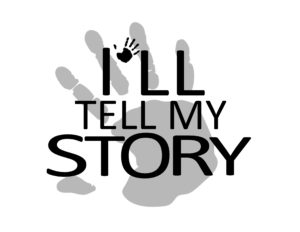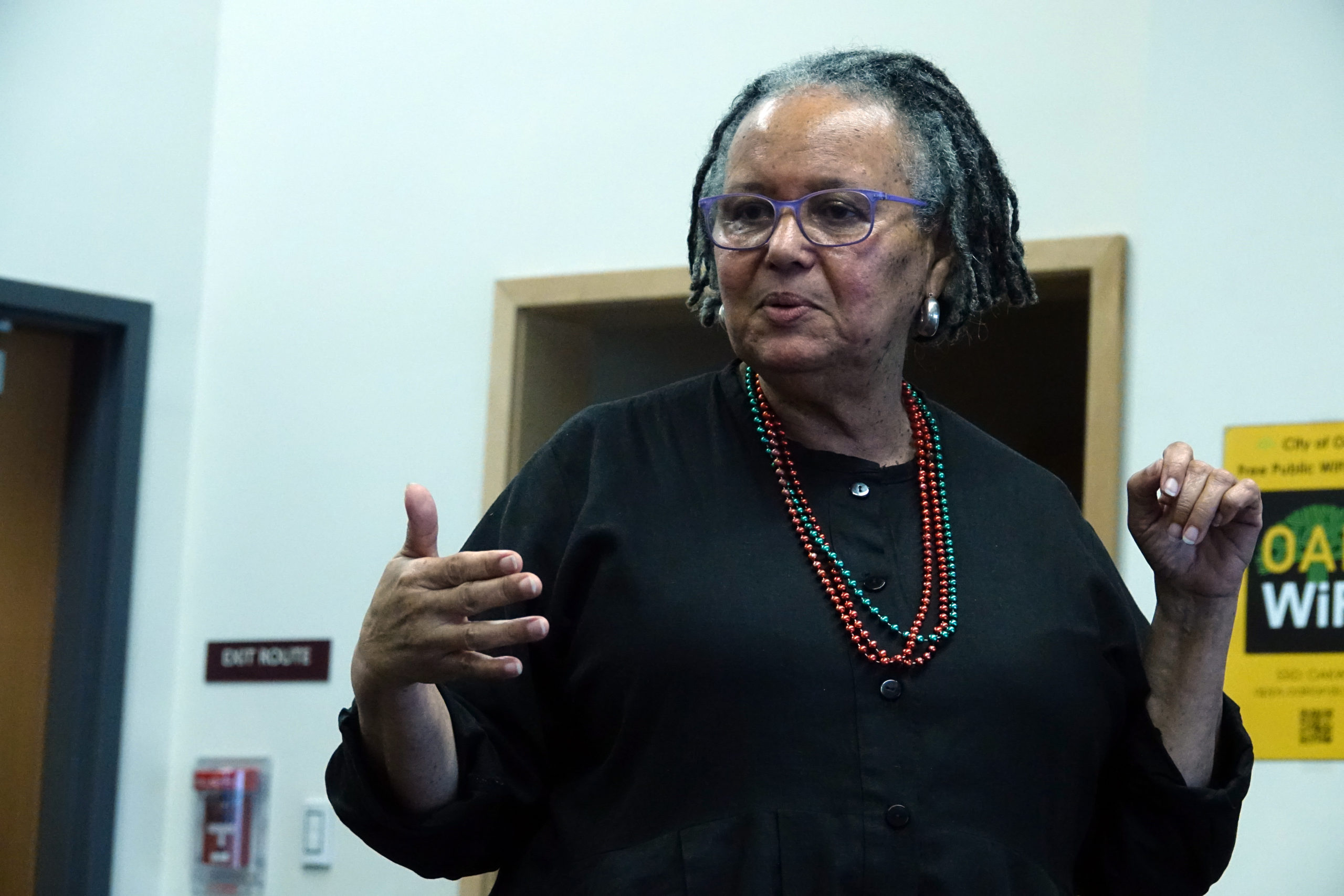I’ll Tell My Story

I’ll Tell My Story Produced five 3-min films created by five formerly incarcerated men and women. Products used in community based organizing campaigns, Prop 47. 9/20 – 9/26/2014, co-produced with Center for Digital Storytelling.

Perseverance
Sajad Shakoor’s Pakistani family has lived in the US since the 1930’s. As a young man, he had issues fitting in with his peers. It led him to gangs. Under the 3 strikes sentencing a conviction for “inciting a fist fight” caused Sajad to spend 21 years in CA prisons. During that time, he completed his GED, earned his BA and is now working on a Ph.D. Sajad has been home for less than a year. He is committed to sharing his story and continues his inmate leadership developed in San Quentin.
Sajad’s story is part of a project that supported formerly incarcerated people in telling their story, their way. These projects were created with the help of Opal Palmer Adisa who led a writing workshop, Kathy Sloane who shared her photographic work and views on taking notice of the world we are submerged in, Center for Digital Storytelling’s staff and volunteers and the board of directors at Sarah Webster Fabio Center for Social Justice (SWFCenter). Funding was a combination of events the SWFCenter launched, crowd funding and a grant from California’s for Safety and Justice (proponents of proposition 47).There are 5 stories in the series, and creating them took 1 week from writing to finish. Thank you, to all who contributed.
Together the stories share the personal dilemmas that caused or are the result of incarceration. Either way, the stories make it clear California needs to rethink its incarceration legacy.
Sajad’s story is part of a project that supported formerly incarcerated people in telling their story, their way. These projects were created with the help of Opal Palmer Adisa who led a writing workshop, Kathy Sloane who shared her photographic work and views on taking notice of the world we are submerged in, Center for Digital Storytelling’s staff and volunteers and the board of directors at Sarah Webster Fabio Center for Social Justice (SWFCenter). Funding was a combination of events the SWFCenter launched, crowd funding and a grant from California’s for Safety and Justice (proponents of proposition 47).There are 5 stories in the series, and creating them took 1 week from writing to finish. Thank you, to all who contributed.
Together the stories share the personal dilemmas that caused or are the result of incarceration. Either way, the stories make it clear California needs to rethink its incarceration legacy.
For this project, SWFCenter explored California’s addiction to over-incarceration. After more than a year of networking and research, the storytelling project began with a five-day workshop that resulted in 5 stories by 5 formerly incarcerated men and women. The resulting 3-minute shorts become tangible demonstrations of why Californians must continue to reverse those policies that result in over incarceration.
Accomplishing the production of “I’ll Tell My Story” films was the result of a partnership with Joe Lambert, of what was called The Center for Digital Storytelling but is now known as The Story Center. The Story Center has been facilitating storytelling workshops for over 25 years.
Light at The End of the Tunnel
Sandra Buford is the mother of 3 adults. In 1992, she was 33 and convicted of “kidnap for the purpose of robbery.” Sandra was sentenced to Chowchilla Women’s Prison for seven to life. After 10 years, Sandra began turning her life around. She is back now, after 21 years and she’s committed to being successful. Sandra works two jobs and is looking forward to making a positive impact on the community and the people around her.
Sandra’s story is part of a project that supported formerly incarcerated people in telling their story, their way.
These projects were created with the help of Opal Palmer Adisa who led a writing workshop, Kathy Sloane who shared her photographic work and views on taking notice of the world we are submerged in, Joe Lambert and crew at Center for Digital Storytelling’s staff and the board of directors of Sarah Webster Fabio Center for Social Justice (SWFCenter).Together the stories share the personal dilemmas that caused or are the result of incarceration. Either way, the stories make it clear California needs to rethink its incarceration legacy.
I’m Living My Life Regardless of Her!
Kimberly Gamboa needed her mother’s approval and it kept her self-esteem low. While she parents her children differently, trouble with her son leads to losing her kids and imprisonment. She fights to get her kids back, she works the program to improve herself and eventually the family is reunited, as they always should have been.
SWFCenter launched fundraisers, held crowd funding campaigns, and eventually received funding from Californians for Safety and Justice, a project of the Tides Center and proponents of Proposition 47.”
The storytellers were referred to SWFCenter from partner organizations (i.e. Legal Services for Prisoners with Children, Alameda County Probation, and Safe Return). Each organization has had a long history of successful work in the reentry field and the successful reduction of barriers for those returning home and trying to reestablish their lives. The films are a compelling case for continued reform. They speak, not only to what is askew in the story but are also reflective of systemic problems.
Back(pack)
Jerry Beat shares his journey through 25 convictions to finally being identified as someone in need of help with addiction. He began learning to love himself, goes to college and work with others who need help, too.
mobile site below
Perseverance
Sajad Shakoor’s Pakistani family has lived in the US since the 1930’s. As a young man, he had issues fitting in with his peers. It led him to gangs. Under the 3 strikes sentencing a conviction for “inciting a fist fight” caused Sajad to spend 21 years in CA prisons. During that time, he completed his GED, earned his BA and is now working on a Ph.D. Sajad has been home for less than a year. He is committed to sharing his story and continues his inmate leadership developed in San Quentin.
Sajad’s story is part of a project that supported formerly incarcerated people in telling their story, their way. These projects were created with the help of Opal Palmer Adisa who led a writing workshop, Kathy Sloane who shared her photographic work and views on taking notice of the world we are submerged in, Center for Digital Storytelling’s staff and volunteers and the board of directors at Sarah Webster Fabio Center for Social Justice (SWFCenter). Funding was a combination of events the SWFCenter launched, crowd funding and a grant from California’s for Safety and Justice (proponents of proposition 47).There are 5 stories in the series, and creating them took 1 week from writing to finish. Thank you, to all who contributed.
Together the stories share the personal dilemmas that caused or are the result of incarceration. Either way, the stories make it clear California needs to rethink its incarceration legacy.
Sajad’s story is part of a project that supported formerly incarcerated people in telling their story, their way. These projects were created with the help of Opal Palmer Adisa who led a writing workshop, Kathy Sloane who shared her photographic work and views on taking notice of the world we are submerged in, Center for Digital Storytelling’s staff and volunteers and the board of directors at Sarah Webster Fabio Center for Social Justice (SWFCenter). Funding was a combination of events the SWFCenter launched, crowd funding and a grant from California’s for Safety and Justice (proponents of proposition 47).There are 5 stories in the series, and creating them took 1 week from writing to finish. Thank you, to all who contributed.
Together the stories share the personal dilemmas that caused or are the result of incarceration. Either way, the stories make it clear California needs to rethink its incarceration legacy.
For this project, SWFCenter explored California’s addiction to over-incarceration. After more than a year of networking and research, the storytelling project began with a five-day workshop that resulted in 5 stories by 5 formerly incarcerated men and women. The resulting 3-minute shorts become tangible demonstrations of why Californians must continue to reverse those policies that result in over incarceration.
Light at The End of the Tunnel
Sandra Buford is the mother of 3 adults. In 1992, she was 33 and convicted of “kidnap for the purpose of robbery.” Sandra was sentenced to Chowchilla Women’s Prison for seven to life. After 10 years, Sandra began turning her life around. She is back now, after 21 years and she’s committed to being successful. Sandra works two jobs and is looking forward to making a positive impact on the community and the people around her.
Sandra’s story is part of a project that supported formerly incarcerated people in telling their story, their way. These projects were created with the help of Opal Palmer Adisa who led a writing workshop, Kathy Sloane who shared her photographic work and views on taking notice of the world we are submerged in, Joe Lambert and crew at Center for Digital Storytelling’s staff and the board of directors of Sarah Webster Fabio Center for Social Justice (SWFCenter).There are 5 stories in the series and creating them took 1 week from writing to finish. Thank you, to all who contributed.
Together the stories share the personal dilemmas that caused or are the result of incarceration. Either way, the stories make it clear California needs to rethink its incarceration legacy.
Accomplishing the production of “I’ll Tell My Story” films was the result of a partnership with Joe Lambert, of what was called The Center for Digital Storytelling but is now known as The Story Center. The Story Center has been facilitating storytelling workshops for over 25 years.
I’m Living My Life Regardless of Her!
Kimberly Gamboa needed her mother’s approval and it kept her self-esteem low. While she parents her children differently, trouble with her son leads to losing her kids and imprisonment. She fights to get her kids back, she works the program to improve herself and eventually the family is reunited, as they always should have been.
SWFCenter launched fundraisers, held crowd funding campaigns, and eventually received funding from Californians for Safety and Justice, a project of the Tides Center and proponents of Proposition 47.”
Back(pack)
Jerry Beat shares his journey through 25 convictions to finally being identified as someone in need of help with addiction. He began learning to love himself, goes to college and work with others who need help, too.